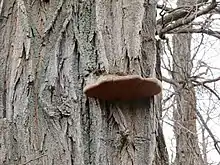Phellinus robiniae
Phellinus robiniae, commonly called the cracked cap polypore, is a fungus of the family of Hymenochaetaceae. The fungus primarily infests black locusts, aided by openings caused by Megacyllene robiniae infestation, but also grows on various other trees such as Carya, oak, and Acacia. Cracked cap polypore is sympatric with most of its hosts. It has a brown spore print, leaving brown streaks on the tree below the fungus.[2]
| Phellinus robiniae | |
|---|---|
 | |
| Phellinus robiniae infecting black locust | |
| Scientific classification | |
| Kingdom: | Fungi |
| Division: | Basidiomycota |
| Class: | Agaricomycetes |
| Order: | Hymenochaetales |
| Family: | Hymenochaetaceae |
| Genus: | Phellinus |
| Species: | P. robiniae |
| Binomial name | |
| Phellinus robiniae | |
References
- Kuo, Michael. "Phellinus robiniae (MushroomExpert.Com)". www.mushroomexpert.com. Retrieved 22 November 2019.
- Roehl, Thomas (13 April 2018). "#081: Phellinus robiniae, the Cracked Cap Polypore". Fungus Fact Friday. Retrieved 22 November 2019.
This article is issued from Wikipedia. The text is licensed under Creative Commons - Attribution - Sharealike. Additional terms may apply for the media files.